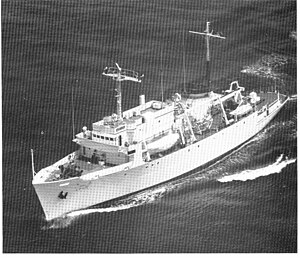USS S. P. Lee may refer to the following ships operated by the United States Navy:
The Defoe Shipbuilding Company was a small ship builder established in 1905 in Bay City, Michigan, United States. It ceased to operate in 1976 after failing to renew its contracts with the United States Navy. The site of the former company is now being developed for business and housing on the bank of the Saginaw River.

SS Mission San Fernando was a Type T2-SE-A2 tanker built for the United States Maritime Commission during World War II. After the war she was acquired by the United States Navy as USS Mission San Fernando (AO-122). Later the tanker transferred to the Military Sea Transportation Service as USNS Mission San Fernando (T-AO-122). She was a member of the Mission Buenaventura-class oiler and was named for Mission San Fernando Rey de España in Los Angeles. She was later renamed USNS Muscle Shoals (T-AGM-19), and, later, USNS Vanguard (T-AG-194).
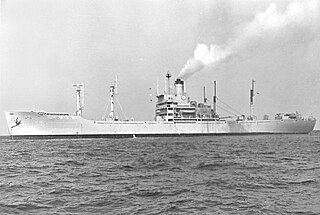
USNS Dutton (T-AGS-22) was an oceanographic survey ship for the United States Navy from the late 1950s through the 1980s. She was launched as SS Tuskegee Victory in 1945, Maritime Commission hull number MCV 682, a type VC2-S-AP3 Victory ship. In her U.S. Navy service, she was named after Captain Benjamin Dutton, Jr., and was the second U.S. Navy ship named in his honor.

USNS Bowditch (T-AGS-21) was the lead ship of her class of oceanographic survey ships for the United States Navy. Launched as the SS South Bend Victory in 1945, Maritime Commission hull number MCV 694, a type VC2-S-AP3 Victory ship, she was named for Nathaniel Bowditch, the second U.S. Navy vessel named in his honor. The ship was acquired by the Navy in August 1957 and converted to an AGS at Charleston Naval Shipyard. Named Bowditch on 8 August 1957 and placed in service 8 October 1958 for operation by the Military Sea Transportation Service (MSTS).
USNS Michelson (T-AGS-23) was a Bowditch class oceanographic survey ship of the United States Navy. Launched as the SS Joliet Victory in 1944, Maritime Commission hull number MCV 114, a type VC2-S-AP3 Victory ship, she was named after Albert Abraham Michelson. The ship was reactivated from the James River Maritime Administration Reserve Fleet on 8 February 1958, delivered to the Navy Department at the Philadelphia Naval Shipyard on 8 August 1957 and converted to an AGS by the Charleston Naval Shipyard. USNS Michelson (AGS‑23) was placed in service on 15 December 1958 under the operational control of MSTS Atlantic.

USNS Wyman (T-AGS-34) was an oceanographic survey vessel laid down on 18 July 1968 by the Defoe Shipbuilding Company of Bay City, Michigan. Launched on 30 October 1969, sponsored by Mrs. Francis J. Blouin, wife of the Deputy Chief of Naval Operations, Vice Admiral Francis J. Blouin; she was accepted by the Military Sealift Command (MSC) on 19 November 1971 at the Boston Naval Shipyard.
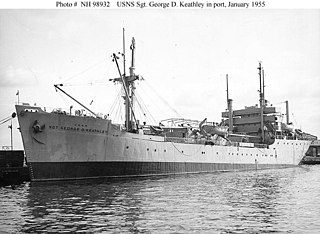
USNS Sgt. George D. Keathley, was a World War II United States cargo vessel that was used for troop transport and later converted to a survey vessel. She was laid down and launched as MS Alexander R. Nininger, Jr., then renamed MS Acorn Knot. She was put into US Army service as USAT Acorn Knot, then renamed USAT Sgt. George D. Keathley. She was transferred to the US Navy and became USNS Sgt. George D. Keathley (T-APC-117), but was later re-designated T-AGS-35. She was leased to the Republic of China, where she served as Chu Hwa (AGS-564). Both Nininger and Keathley were posthumous Medal of Honor recipients.

USNS Coastal Crusader (AK-220/ORV-16/T-AGM-16/AGS-36) was an Alamosa-class cargo ship that was constructed for the US Navy during the closing period of World War II. She was later acquired by the US Army in 1946 and the US Air Force in 1957 before being reacquired by the USN in 1964 and as a missile range instrumentation ship.

USNS James M. Gilliss (T-AGOR-4) was a Robert D. Conrad-class oceanographic research ship acquired by the U.S. Navy in 1962. The ship was operated by the Military Sea Transportation Service and managed by the Naval Oceanographic Office as one of the "Navy Pool" vessels serving various Navy laboratories and projects in the Atlantic Ocean. After active Navy pool service the ship was assigned to the University of Miami to operate as part of the University-National Oceanographic Laboratory System (UNOLS) fleet until 1979.
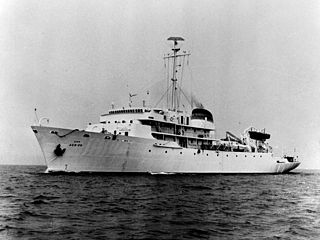
USNS Silas Bent (T-AGS-26) was a Silas Bent class survey ship acquired by the United States Navy in 1964 and delivered to the Military Sealift Command in 1965. Silas Bent spent her career in the Pacific Ocean performing oceanographic surveys. The ship was equipped with the Oceanographic Data Acquisition System (ODAS) as were the later oceanographic survey ships USNS Kane (T-AGS-27) and USNS Wilkes (T-AGS-33).
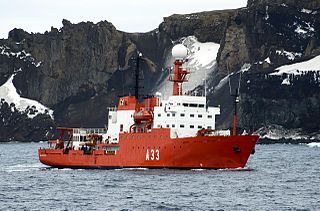
BIO Hespérides (A-33), is a Spanish polar research vessel. She was built in 1990, by Bazán Shipyards of Cartagena, Spain. Hespérides is used to service the research bases in Antarctica, mainly the Spanish Juan Carlos I Antarctic Base, as well as to perform research voyages. It is operated by the Spanish Navy and the responsible of the scientific equipment is the Spanish National Research Council.
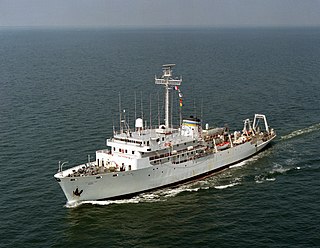
The Silas Bent class is frequently found applied to four ships though the Naval Vessel Register and some sources officially break them into the subclasses of AGS-26 and AGS-33. Silas Bent was the first of the first four purpose built ships for U.S. Navy surveys. Previous ships had been modifications of various naval types.
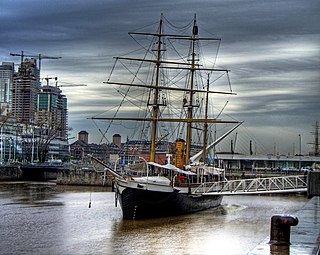
The corbeta (corvette) ARA Uruguay, built in England, is the largest ship afloat of its age in the Armada de la República Argentina, with more than 140 years passed since its commissioning in September 1874. The last of the legendary squadron of President Sarmiento, the Uruguay took part in revolutions, ransoms, expeditions, rescues, and was even floating headquarters of the Navy School. During its operational history 1874–1926 the Uruguay has served as a gunboat, school ship, expedition support ship, Antarctic rescue ship, fisheries base supply ship, and hydrographic survey vessel, and is now a museum ship in Buenos Aires. The ship was built in 1874 at Laird Bros. shipyard of Birkenhead, England, at a cost of £32,000. This ship is rigged to a barque sailplan. The ship's steel hull is sheathed in teak.

ARA Comodoro Rivadavia (Q-11) is a survey ship of the Argentine Navy assigned to the national Hydrographic Naval Service which among other things is responsible of the maintenance of nautical charts and navigational aids
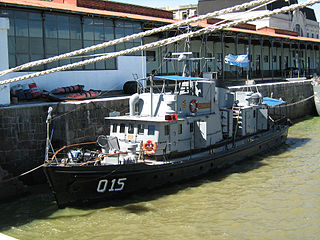
ARA Cormorán (Q-15) is a hydrographic survey boat of the Argentine Navy, built in the Río Santiago Shipyard and based in Buenos Aires. The vessel is named after the cormorant, a seabird that inhabits Argentina’s littoral, and is the fourth Argentine naval ship with this name.
ARA Santa Cruz was an auxiliary ship of the Argentine Navy, built in the Fairfield Shipbuilding & Engineering Shipyard, Govan, Scotland, in 1921. She was transferred to the YPF tanker fleet after arrival in Argentina, and remained in YPF service until decommissioned and scrapped in 1948. The vessel was named after the Argentine province of Santa Cruz, and is the ninth Argentine naval ship with this name.

USNS Chauvenet (T-AGS-29) was a multi-function survey ship laid down on 24 May 1967, at Upper Clyde Shipbuilding Corp., Glasgow, Scotland. The ship was the second survey ship, Chauvenet (AGS-11) being the first, named for William Chauvenet (1820-1870). He was instrumental in the founding of the United States Naval Academy at Annapolis, MD. The mathematics department of the US Naval Academy in Annapolis was founded by Chauvenet and is housed in Chauvenet Hall. Chauvenet was launched on 13 May 1968, delivered to the US Navy, 13 November 1970 and placed in service with the Military Sealift Command (MSC) as USNS Chauvenet (T-AGS-29). The ship conducted coastal hydrographic and topographic surveys under the technical direction of the Oceanographer of the Navy through the U.S. Naval Oceanographic Office (NAVOCEANO). The ship was assigned to the Pacific for surveys, sister ship Harkness (T-AGS-32) was assigned Atlantic duties, doing so until inactivated in November 1992.

A bronze statue of Lázaro Cárdenas is installed in Puerto Vallarta's Lázaro Cárdenas Park, in the Mexican state of Jalisco. It was created by a group of students from the University of Michoacán and it was unveiled in 1970. As part of a municipal rehabilitation program, the statue was restored in 2020 and authorities decided to rotate it 180°.
